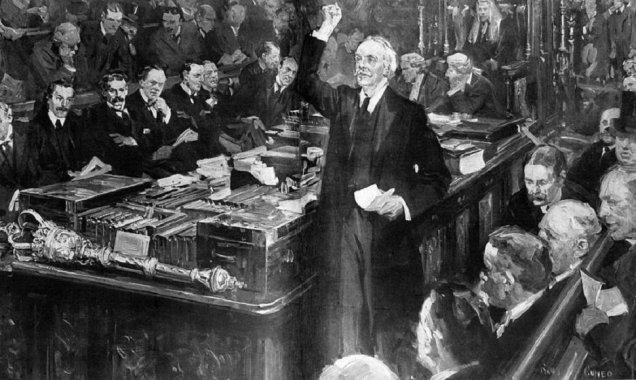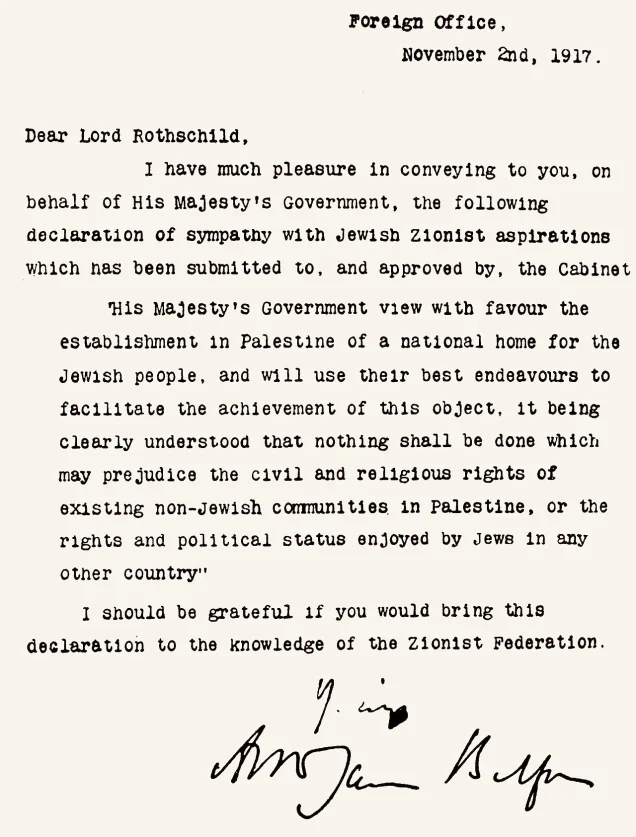The Balfour Declaration, issued on November 2, 1917, is attributed to the British Foreign Secretary, Arthur James Balfour, known for his sympathy with Zionist ideas and his support for the Zionists. It was a statement of sympathy and endorsement for the establishment of a national home for the Jewish people in Palestine, addressed by Balfour to Lord Lionel Rothschild.

Balfour was born in 1848 in Whittingehame, which is now known as Luthian and located in Scotland. He studied the teachings of the Old Testament (Torah) during his early education and held various political positions in his country, starting from his election to Parliament in 1874, culminating in his appointment as Prime Minister in 1902 and serving as the Foreign Secretary from 1916 to 1919. He passed away at the age of 82.

Balfour opposed Jewish migration to Eastern Europe, fearing its movement towards Britain. He believed it was better for Britain to exploit Jews in supporting the kingdom from outside Europe. He believed in the Zionist ability to influence America to join World War I alongside Britain. His message to Lord Rothschild was the first step taken by the West to establish a Jewish entity in Palestine, giving what he did not possess to those who did not deserve it.
The text of the message states: "I have much pleasure in conveying to you, on behalf of His Majesty's Government, the following declaration of sympathy with Jewish Zionist aspirations, which has been submitted to, and approved by, the Cabinet: His Majesty's Government view with favor the establishment in Palestine of a national home for the Jewish people, and will use their best endeavors to facilitate the achievement of this object, it being clearly understood that nothing shall be done which may prejudice the civil and religious rights of existing non-Jewish communities in Palestine, or the rights and political status enjoyed by Jews in any other country. I would be grateful if you would bring this declaration to the knowledge of the Zionist Federation."
The Irgun Tsvai Leumi, the Hebrew name for the National Military Organization, was formed in 1931 after it split from the Haganah Zionist organization under the leadership of Abraham Tehomi. This military group is attributed to many of the tragedies and massacres against the Palestinian people. Its emblem featured a map of Palestine and Jordan with a rifle, surrounded by the Hebrew text "Rak Kach" meaning "Only Thus."
One of the primary reasons for the Irgun's breakaway from the Haganah was their dissatisfaction with the British-imposed restrictions on dealing with Palestinian rebels. They openly disregarded Arabs, advocated for the historic land of Israel on both sides of the river (all of Palestine and East Jordan). Prominent leaders included Israel's Prime Minister Menachem Begin and Isaac Shamir before Shamir joined Stern in 1940.
The Irgun was considered the most powerful Zionist organization during that period, not just due to its size but also because of the numerous terrorist operations it carried out against the Palestinian people and British mandate authorities. It was later classified as a terrorist organization, alongside the Stern Gang. The organization committed dozens of crimes against the Palestinian people from its inception until its dissolution in 1948, forming, alongside other Zionist military organizations, the nucleus of the Israeli Defense Forces. The Deir Yassin massacre on April 9, 1948, conducted in collaboration with the Stern Gang, was among its most heinous crimes, resulting in the deaths of over 245 Palestinian civilians.
The group also targeted British military personnel, as evidenced by the bombing of the administrative headquarters of the British Civil Administration in the King David Hotel in Jerusalem on July 22, 1946.
Lehi (aka: Lohamei Herut Israel, or Fighters for the Freedom of Israel)
The organization initially named "Lohamei Herut Israel" or "Fighters for the Freedom of Israel" was founded in 1940 by the Jew Abraham Stern. The organization was later named after him following his death. The formation of the Stern Gang came directly after the split within the ranks of the Irgun Zionist organization, following the death of the Jewish leader Jabotinsky in the same year. The primary reason for its establishment was the founder's desire and his followers to operate independently, outside the directives of the World Zionist Organization, away from the Haganah.
Despite the British forces being at war with Nazi Germany, the Jews' staunch adversaries at that time, during World War II, the Stern Gang saw the necessity to fight against the British Mandate forces in Palestine as they hindered the establishment of the state of Israel.
In 1942, the founder of the gang, Abraham Stern, was killed by British forces. In retaliation, the gang assassinated Lord Moyne, the British Minister for Middle East Affairs, in Cairo on November 6, 1944. Notably, the bombing of the King David Hotel in 1947 and the Deir Yassin massacre in 1948—coordinated with the Irgun—were among its most violent crimes.
Although the organization merged into the Israeli Defense Forces in May 1948, a rebellion occurred within its ranks. The rebels assassinated Count Bernadotte, leading to international outrage. The Israeli government arrested and imprisoned the perpetrators, but they were later released under a special pardon.
Israeli politicians and government officials still commemorate the anniversary of the movement's founder's death every year. Israel issued a postage stamp bearing his image in 1978. It's worth noting that Isaac Shamir, the late Prime Minister of Israel, was the leader of the movement's operations in the late 1940s.
The Haganah
Haganah, a Hebrew word meaning "defense," was a Zionist military organization established in Jerusalem in 1920, succeeding the Hishamir organization or "The Guard," founded in 1909 in Palestine to provide security for and reinforce settlements.
Initially, the Haganah was a secretive military organization named Haganah and Avoda, meaning "defense and work," later omitting the word "work." Initially affiliated with the Labor Union, it later aligned with the Mapai party and Histadrut. Despite its charter emphasizing its non-partisanship and portraying itself as an organ for the Zionist settlement gathering, it initially maintained ties with political entities.
The organization's well-structured framework paved the way for what is now the Israeli Occupation Army. It contributed to the establishment of 50 Jewish settlements and the displacement of Palestinians from their homes. Initially, it operated as a civilian organization under a civilian administration. After the Arab Revolt in 1929, its nature dramatically changed as thousands of young men from Jewish settlements joined, importing foreign weapons and establishing workshops to manufacture hand grenades and light military equipment.
The Haganah fiercely opposed Zionist groups fighting the British, considering them obstacles to the promised Israeli state. Among these groups was the Lehi organization, which later transformed into the Stern Gang, providing British authorities assistance in establishing and training the Haganah's striking force, known as the Palmach.
Prior to the declaration of the State of Israel, the Haganah numbered around 36,000, in addition to 3,000 Palmach members. Its organizational structure was completed, facilitating its transformation into a unified and professional army for the Zionist state. On May 21, 1948, Ben-Gurion issued an order dissolving the Haganah's old framework, transforming it into the Israeli Defense Forces.
The Salvation Army
The Salvation Army (not the current one) was a volunteer army formed by the Arab League in December 1947 to militarily intervene and assist Palestinians in resisting the United Nations decision to partition Palestine and create two states – one Jewish and one Palestinian – following a recommendation from Britain.
The army consisted of eight brigades led by fighters from Syria, Iraq, and Palestine. Around 7,700 volunteers joined, including 2,500 from within Palestine and the rest from various Arab and Islamic countries. These volunteers received training at camps in Qatana, Syria, with Fawzi al-Qawuqji appointed as their leader.
The brigades of the Army of Rescue began arriving in Palestine in January 1948 and launched unsuccessful attacks on several Jewish settlements. Fawzi al-Qawuqji entered Palestine on March 7 of that year, assuming leadership in Jenin, Nablus, and Tulkarm.
While initially able to manage some significant battles, the Army of Rescue lacked a general staff structure, suffered from a shortage of officers, poor weaponry, insufficient soldiers, and inadequate military training. In the first two weeks of 1948, they attacked the Mishmar HaEmek settlement but were repelled by Jewish Haganah forces. Additionally, on May 9 and 10, the Army of Rescue lost the city of Safed to the Palmach unit affiliated with Haganah.
Despite facing significant losses, the soldiers of the Army of Rescue were acknowledged as fierce fighters, noted in the history of Haganah. Haganah leaders acknowledged that the Arab Liberation Army managed to repel an attack by one of its units targeting the villages of Al-Kafr and Husha on April 14 and forced them to retreat.
Fawzi al-Qawuqji withdrew from Palestine on July 25, 1948, after his army faced several defeats, unable to prevent the fall of Tiberias, Haifa, Acre, and Jaffa into Jewish hands.
The UNRWA
It's the abbreviated name for the United Nations Relief and Works Agency for Palestine Refugees in the Near East. The agency focuses on providing education, healthcare, social services, and emergency aid to over 4.4 million registered Palestinian refugees living in Gaza, the West Bank, Jordan, Syria, and Lebanon. With a staff exceeding 24,000 employees, a significant portion are Palestinian refugees themselves.
Established in the aftermath of the Arab-Israeli conflict in 1948 by UN General Assembly Resolution 202 in December 1949, it began its field operations in early May 1950. Originally set to function for 30 years, the UN General Assembly has continually renewed its mandate due to the ongoing Palestinian issue, extending the last mandate renewal until June 20, 2011.
UNRWA defines Palestinian refugees as those who resided in Palestine between June 1946 and lost their homes and livelihoods due to the 1948 war. This definition includes their descendants.
One-third of the registered refugees live in 58 recognized camps within the agency's operational area in Jordan, Syria, Lebanon, the West Bank, and Gaza. The remaining two-thirds reside in scattered locations within major cities of these countries, the West Bank, and Gaza.
The Tahjir/Displacement/Transfer
The concept of the Jewish migration was formulated by Theodor Herzl, referring to the complete expulsion of Palestinians from the Palestinian land and relocating them outside historic Palestine, now known as Israel. This concept aimed at settling Palestinian refugees in Lebanon, Syria, Jordan, and other Arab and foreign countries. It also implied suffocating Palestinians in the West Bank and Gaza to push them into migration.
Israel, in its early days, resorted to terror tactics to displace Palestinians through massacres, home demolitions, and intimidation to evacuate Palestinian lands. Post the 1967 war, Israel pursued indirect displacement by imposing economic hardship and security conditions in the West Bank and Gaza to compel residents to seek work or safety in other countries.
The forced migration carried out by Jews through terrorist, clandestine, and public organizations constitutes a deliberate form of ethnic cleansing, not a side effect of the Arab-Israeli conflict or the 1948 war. Between 1947 and 1949, the Israeli army followed Plan Dalet in Arab areas, involving principles of assault, capture, sometimes killing men, raping women, displacing civilians, looting, destroying homes, and detonating ruins to prevent the possible return of the displaced. Eventually, seizing the money and jewelry of displaced women and the elderly also took place.
When the Palestinian issue reached its climax in 1947 and 1948, influential circles in Europe and America accepted the idea of expelling Palestinians from Palestine. Zionist military organizations and later the Israeli army forcibly expelled over 750,000 Palestinians on the eve of Israel's establishment.
